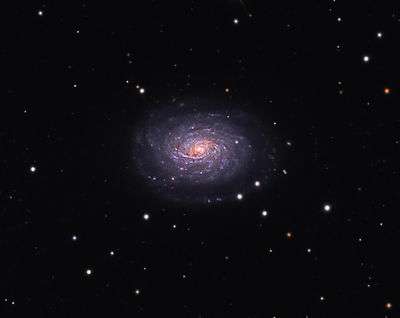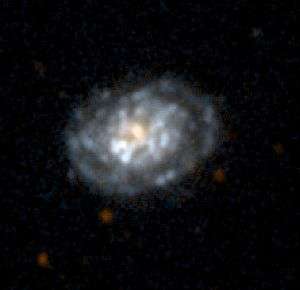NGC 5962
| NGC 5962 | |
|---|---|
|
An ultraviolet image of NGC 5962 taken with GALEX. | |
| Observation data (J2000 epoch) | |
| Constellation | Serpens Caput |
| Right ascension | 15h 36m 31.6s[1] |
| Declination | +16° 36′ 28″[1] |
| Redshift | 1957 ± 2 km/s[1] |
| Apparent magnitude (V) | 12[1] |
| Characteristics | |
| Type | SA(r)c[1] |
| Apparent size (V) | 3′.0 × 2′.1[1] |
| Other designations | |
| UGC 9926,[1] PGC 55588[1] | |
NGC 5962 is a spiral galaxy in the constellation Serpens Caput and is the brightest member of the Serpens galaxy cluster. Along with a populated nucleus, it has a relatively large core, but a small central bulge, in which spiral arms begin to unfurl. It appears to have three smaller, orange-hued, dwarf galaxy satellites.
About six solar masses of material form into stars every year in NGC 5962. It is an 11.3 magnitude object that appears 2.5' × 1.5' in the night sky at 90 million light years away, but is still associated with the Virgo supercluster. It has a right ascension of 15h 36.5m and a declination of 16°36'.
Discovery
NGC 5962 was discovered by British astronomer Sir. William Herschel in 1784 using his Newtonian reflector, the largest telescope in the world at that time.
Observations
It has been measured by the GALEX spacecraft that NGC 5962 has a redshift of 1957 ± 2 km/s.
Physical Characteristics

The exact size or mass of the galaxy is not known, but there have been estimates of its mass using the velocities of its companion galaxies. The number of stars estimated within NGC 5962 reaches (1 ± 2.5) × 10 to the 12th power stars.
External links
References
- Sky and Telescope.com/sky/wonders-NGC5962 magazine/June issue pg. 56
